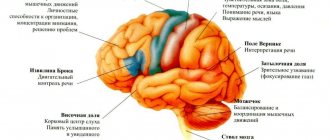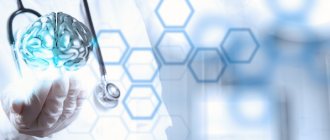To make an appointment with a doctor
Calling a pediatrician to your home
Our doctors
Our prices
March 12, 2021
Each of us, more than once in our lives, has experienced the sensation of imaginary rotation of space around ourselves or ourselves in space, that is, we have experienced dizziness. It is not a separate disease, but can be a sign of a number of quite serious diagnoses. Medical statistics claim that in terms of prevalence, this symptom ranks second in neurology after headache.
Dizziness can be systemic, when the sensation of rotating space seems very realistic and intense, and non-systemic, when there is a feeling of uncertainty, unsteadiness, loss of balance during movement, fear of loss of consciousness.
The main cause of dizziness is a failure in the coordinated functioning of the visual, proprioceptive systems and vestibular apparatus. It can be caused by various factors. Both adults and children suffer from dizziness, and they occur much more often than is commonly believed. Diagnosing dizziness due to the subjective nature of the sensations is not easy. This is even more difficult to do with children, because it is difficult for them to explain what is happening to them. And a very young child is not able to complain of dizziness at all. But it is extremely important for parents to notice this phenomenon in time in order to exclude a serious illness.
How can you tell if your child is dizzy?
You can assume that a small child is dizzy based on his behavior:
- suddenly he is distracted from his favorite activity, he looks confused and incomprehensible, he tries to focus his gaze on some point, but he fails;
- closes eyes and/or lies face down; intuitively presses against the wall, headboard, chair, trying to stay on his feet, afraid to make a movement;
- does not want to get out of bed, especially after illness;
- Sometimes nystagmus is observed - rapid movement of the eyeballs, which is involuntary.
Causes of dizziness in children
Dizziness in children can be one of the symptoms of an incipient illness. However, it is also caused by reasons not related to the painful condition. Among them:
- staying in a stuffy room, lack of oxygen;
- excitement and stress, hormonal processes in adolescence;
- high ambient temperature;
- motion sickness in transport;
- feeling of hunger, decreased blood pressure.
Isolated cases, after which the child quickly returns to normal, do not require a visit to the doctor. But frequent dizziness in a child for no apparent reason may indicate serious health problems. Among them:
- neuroses and other mental pathologies;
- lesions of the central nervous system, epilepsy and other neurotic diseases;
- various inflammatory processes;
- disturbances in the activity of the vestibular apparatus;
- infectious diseases;
- migraine;
- decreased hemoglobin level, anemia;
- diseases of the inner and middle ear;
- head injuries, concussion;
- brain tumors;
- helminthiasis, poisoning, allergies.
It is very important to determine in time why a child is experiencing dizziness in order to prevent the progression of serious illnesses.
Dizziness in neuropediatrics
In neuropediatrics, many pathological conditions are accompanied by dizziness (at least a hundred of them) [1]. S. V. Morozova et al. (2002) indicate that dizziness is one of the most common symptoms encountered in medical practice (about 3–4% of the reasons for the total number of visits to doctors) [2].
Dizziness (vertigo) is a feeling of deviation or spinning of both one’s own body and surrounding objects. In the first case, we can talk about subjective (non-systemic) dizziness, and in the second about objective (systemic) [1].
In general, dizziness is a feeling of apparent rotation, displacement of surrounding objects or one’s own body, that is, manifested by signs of a violation of spatial orientation [1, 3, 4].
Etiological and pathogenetic factors
The main cause of dizziness is an imbalance of information coming from sensory stabilizing systems (vestibular, visual, somatosensory), leading to a violation of spatial orientation.
Dizziness occurs when there is inadequate conduction of a nerve impulse from the vestibular analyzer to the brain (especially to its cortex), when there is no coordination with one or another real movement. As a result of the inconsistency of this impulse with others emanating from the eyes and somatosensory system, a hallucinatory perception of one’s own and external movements arises.
Dizziness develops as a result of an imbalance of sensory information coming from the main afferent systems that provide spatial orientation (vestibular, visual, proprioceptive), but a significant role belongs to disturbances in the central processing of information and the efferent part of the motor act. Pathological changes in the musculoskeletal system are less significant.
Common causes of central vertigo are trauma, inflammation, demyelination and exogenous toxic lesions of the central nervous system (CNS), and CNS tumors. Central vertigo occurs when there is damage/dysfunction of the pons and/or cerebellum.
Peripheral vertigo occurs when there is damage/dysfunction of the labyrinth or VIII pair of cranial nerves. With peripheral dizziness, compensation occurs faster and more fully than with central dizziness.
Common causes of vertigo in children are diseases of the eustachian tube of the middle ear, but true vertigo can also be caused by labyrinthitis, perilymphatic fistula between the inner and middle ear (inner ear defect), trauma, mastoid or middle ear choleastomy, vestibular neuronitis, benign paroxysmal postural vertigo, Meniere's disease or diseases of the central nervous system [1, 3, 4].
A number of authors suggest considering panic attacks (induced by hyperventilation), cerebellar atrophy, vestibular neuronitis, etc. as causes of dizziness [1].
Approaches to classification
Physiological ones include dizziness that occurs, for example, when watching films with chase scenes, when looking at a moving train (or other type of transport), “sea sickness,” a feeling of motion sickness when ascending an airplane or high-speed elevator, when looking down from a height, etc. d.
Pathological dizziness occurs when the vestibular, visual and somatosensory systems are affected. It may appear with diplopia, incorrectly selected glasses or contact lenses, or impaired proprioceptive sensitivity.
It is generally accepted to divide dizziness into systemic and non-systemic. Systemic vertigo is characteristic of damage to the vestibular system, which consists of the organ of balance in the inner ear, the abducens nerve, the nuclei of the vestibular nerve in the medulla oblongata, associated with the nuclei of the vagus nerve, the red nucleus, the cerebellum, the nuclei of the oculomotor nerve, as well as with the cells of the anterior horns of the spinal cord. brain Systemic vertigo occurs in combination with other cochleovestibular disorders (nausea, vomiting, nystagmus, tinnitus) and often serves as a sign of damage to the vestibular analyzer at various levels (middle ear pathology, neuropathy of the vestibulocochlear nerve, segmental and suprasegmental disorders) [1, 3, 4].
Non-systemic dizziness is a disorder in the picture of a lipotimic state. The cause of syncope can be cardiogenic and vasodepressor disorders, hyperventilation, hypoglycemia, nocturia, orthostatic fainting, etc. With non-systemic dizziness, arterial hypotension and asthenia are often observed (after acute or exacerbation of chronic diseases). Unsystematic dizziness can occur with sudden turns of the head, in stuffy rooms.
Among the types of dizziness, the following are distinguished: 1) auditory (Meniere's disease); 2) gastric (a sign of stomach disease, Trousseau syndrome); 3) labyrinthine (endolymphatic hydrops, Meniere's disease); 4) visual (refractive errors, imbalance of the external muscles of the eye); 5) organic (with damage to the central nervous system); 6) postural (synonym: positional), which occurs when the body position changes, usually from a sitting or lying position [1, 3, 4].
The classification of the causes of dizziness proposed by GR Holt and JR Thomas (1980) includes 8 main groups of etiological factors: 1) inflammatory and non-inflammatory diseases of the middle/inner ear; 2) diseases of the central nervous system; 3) damage to the organs of the neck, including degenerative-dystrophic changes in the cervical spine; 4) metabolic and hematological disorders; 5) drug-induced disorders; 6) infectious lesions; 7) cardiogenic causes; other reasons. The latter includes no more than 10% of cases [1].
2) diseases of the central nervous system; 3) damage to the organs of the neck, including degenerative-dystrophic changes in the cervical spine; 4) metabolic and hematological disorders; 5) drug-induced disorders; 6) infectious lesions; 7) cardiogenic causes; other reasons. The latter includes no more than 10% of cases [1].
Additionally, dizziness is classified as constant and intermittent, paroxysmal and non-paroxysmal, positional (depending on the position of the body) and attitudinal (depending on the movement of the head) [1].
Clinical manifestations
Symptoms depend on the characteristics of certain types of neurological or somatic pathology; they are quite variable. Thus, older children may describe sensations of rotation and spinning, while younger children are more likely to demonstrate imbalance when falling, in the form of stumbling or clumsiness of movement.
Central vertigo often manifests itself in single attacks of varying duration; possible dysarthria, diplopia, numbness, weakness, and less commonly, pronounced nystagmus.
Peripheral dizziness is usually accompanied by nausea and vomiting; when the ear is affected, they are accompanied by decreased hearing, a feeling of fullness and noise in the ear, and otalgia. Attacks can be isolated or recurrent.
When the vestibular system is damaged, there is uncertainty when walking, frequent falls, fear and avoidance of sudden and rapid movements. Unsteadiness of gait, uncertainty when walking and a feeling of intoxication are not always symptoms of disorders of the vestibular system. These symptoms may indicate severe diffuse brain damage [1, 3–5].
Based on children’s descriptions of the sensations of dizziness, M. Hertl (1990) systematized them (scale of sensations of dizziness): 1) rotational dizziness - a feeling of apparent rotation of surrounding objects and one’s own body in the direction opposite to each other; 2) oscillatory dizziness - the patient feels as if the floor is shaking under him; 3) the feeling of an “elevator” - the impression of falling into an elevator shaft; 4) lateropulsion - a feeling of falling to the side [5].
Lesions of the central nervous system of inflammatory origin
Inflammatory lesions of the central nervous system are often accompanied by dizziness. With encephalitis, ventriculitis, hydrocephalus, there is a feeling of swaying, instability, sometimes with disturbances in spatial perception - the size, shape of objects or one's own body (Alice in Wonderland syndrome).
The causes of systemic peripheral vestibular disorders in children are bacterial lesions of the inner ear, viral neurolabyrinthitis, endolymph circulation disorders, traumatic injuries, Meniere's disease and Meniere-like syndromes.
Bacterial, viral or infectious-toxic damage to the labyrinth can be a complication of acute or chronic otitis (tympanogenic labyrinthitis), purulent meningitis (meningogenic labyrinthitis), influenza, mumps, or a manifestation of hematogenous metastasis during sepsis (hematogenous labyrinthitis). The progression of otitis media with the spread of the inflammatory process to the inner ear is often accompanied by vestibular disorders, uncontrollable vomiting, a sensation of rotation and rocking, and nystagmus. Purulent labyrinthitis can lead to irreversible problems with balance and hearing. Serous labyrinthitis, which develops as a result of toxic irritation of the neuroepithelium, is more prognostically favorable.
With a herpetic lesion, general signs of a viral disease are observed, vesicular rashes on the auricle, in the ear canal and even on the eardrum, sometimes on the anterior two-thirds of the same half of the tongue. In such cases, unilateral deafness or hearing loss, rotational vertigo with nystagmus, vomiting, severe pain, unilateral paresis of facial muscles due to true trigeminal neuralgia and facial nerve paralysis develop [1, 3–5].
Endolymph circulation disorders
Endolymph circulation disorders are manifested by attacks of systemic dizziness, nausea, vomiting without changes in hearing. These patients always have a positive Barany test. A common cause of changes in endolymph circulation in the inner ear is the entry of cold air or water into the middle ear cavity due to perforation of the eardrum of traumatic or inflammatory origin. Swimming and diving are dangerous for these children unless the external auditory canal is sealed tightly (for example, with cotton wool soaked in grease). Another cause may be canal cupulolithiasis; in these cases, canal tamponade relieves dizziness and nystagmus [1].
Exogenous toxic damage to the labyrinth
Aminoglycoside antibiotics (amikacin, gentamicin, tobramycin, etc.), antitumor and anthelmintic drugs, as well as salicylic acid preparations, quinine, etc., have significant ototoxicity. In neurological practice, benzodiazepines, anticonvulsants (carbamazepine, phenobarbital, phenytoin), neuroleptics (haloperidol) are widely used. , phenothiazines), which, acting on the central parts of the locomotor system, can cause dizziness. Toxic damage to the labyrinth is caused by botulinum toxin, some mushrooms and poisonous snake bites [1, 3, 4].
Movement sickness
It occurs especially often in children aged 2–12 years (10% of boys and 30% of girls). Clinical symptoms are variable: mild (lethargy, drowsiness, stomach discomfort, pallor or flushing of the face, hypersalivation with increased sweating, moderate increase in blood pressure), moderate (shortness of breath, nausea, vomiting, flatulence, perversion of taste, chills or feeling of heat, headache in the forehead, anxiety, tinnitus), severe (heart rhythm disturbances, spatial disorientation, fainting) [1, 3, 4].
Meniere's disease
A triad of symptoms is characteristic: 1) systemic dizziness (“rotational”); 2) ringing in the ears; 3) various hearing impairments. The duration of attacks averages 2–5 hours (from 10 minutes to 48 hours). Patients often experience a feeling of pressure in the ears. Meniere's disease is paroxysmal in nature and occurs against the background of complete well-being. This disease is observed mainly in older children. In addition to the described triad of symptoms, autonomic disorders, nausea, vomiting, nystagmus, and a feeling of “fullness” in the ears may be observed [1, 3, 4].
In practice, Meniere-like syndromes caused by vascular dyscirculation in autonomic dysfunction and vertebrobasilar insufficiency in osteochondrosis of the cervical spine are more common.
Vertebro-basilar insufficiency
Discirculatory disorders occur in the presence of deformations/anomalies of the vertebral arteries. Characterized by imbalances that increase when the head is turned. There are subjective vestibular manifestations, visual and oculomotor disorders, static and coordination disorders [1, 3–5].
Migraine
Atypical migraine attacks with dizziness are more common in children than in adults. Dizziness may precede a migraine or persist after the end of a cephalgic attack. In some cases, repeated paroxysmal dizziness can transform into typical migraine attacks over time.
With basilar artery migraine syndrome, in addition to dizziness, ataxia, tinnitus, dysarthria, and diplopia are noted (they precede an attack of headache). The first attack of the disease can occur at any age (from infancy to adolescence), and its duration can be up to several hours [1, 3–5].
Traumatic injuries of the vestibular apparatus
Dislocation of the stapes occurs when exposed to sharp objects, unsuccessful removal of a foreign body, or paracentesis. In these cases, dizziness suddenly appears so severe that the child may fall. With traumatic brain injuries with a fracture of the temporal bone pyramid, concussion of the labyrinth, dizziness with hearing loss is often observed.
Central vestibular vertigo is observed with fractures of the base of the skull passing through the pyramid of the temporal bone, accompanied by damage to the membranous semicircular canals and hemorrhage into the labyrinth. A concussion or contusion of the brain may be accompanied by damage to the ear labyrinth. In these cases, dizziness is transient and is triggered by head movement. Usually it persists for a long time (several months or years) [1, 3–5].
Multiple sclerosis (MS)
Of the demyelinating diseases, dizziness of the “Meniere-like” type most often occurs in MS with damage to the pons. Dizziness and a feeling of uncertainty when walking may appear as the initial manifestations of the disease. The diagnosis of MS is established on the basis of clinical, laboratory and instrumental signs [1, 3, 4].
Neurogenetic conditions
Malformations of the central nervous system such as cerebellar agenesis and atrophy, Arnold-Chiari syndrome, in addition to ataxia, are often accompanied by dizziness. Hereditary Friedreich's spinocerebellar ataxia causes dizziness with frequent falls [1, 3–5].
Brain tumors
The sudden onset of attacks of dizziness, headaches with vomiting, bradycardia, and convulsions may be symptoms of a brain tumor. Tumors of the cerebellopontine angle are more often found, usually neurofibromas (neurinomas) in Recklinghausen neurofibromatosis. Considerably less common with the described symptoms are tumors of the fourth ventricle and neoplasms of other localizations [1, 3–5].
Syringobulbia
Syringobulbia is a pathology in which tubular cavity formation (cavitation) of the spinal cord is noted when the cystic lesion spreads to the medulla and pons. In childhood, syringobulbia is sometimes associated with Arnold-Chiari malformation types I and II [1, 3, 4].
Benign paroxysmal vertigo
Benign paroxysmal vertigo usually occurs in children aged 12–36 months. The attacks occur suddenly and are characterized by ataxia, causing falls and refusal to walk or sit. Throughout the attack, the child may experience horizontal or rotational nystagmus. More often, dizziness occurs in the morning, and intensifies when moving to a horizontal position from a sitting position, as well as when turning in bed [1, 3–5].
Epilepsy
Unsystematic dizziness is often observed in children suffering from this disease. The aura before a grand mal (generalized) epileptic seizure may be accompanied by severe dizziness. Absence seizures with short-term loss of tone and short-term psychomotor seizures can give the impression of dizziness. With temporal lobe epilepsy, short-term attacks of non-systemic dizziness may occur, accompanied by unaccountable fear, phenomena of depersonalization and derealization [1, 3–5].
Diagnostics
First of all, you should try to clarify whether we are talking about single (episodic) or recurrent dizziness, as well as what its origin is (central or peripheral).
Systemic dizziness is observed with damage to the peripheral and central vestibular structures. The peripheral structures of the vestibular apparatus include the semicircular canaliculi, ampullae of the vestibule, and the vestibular portion of the vestibular-cochlear nerve. With peripheral damage to the vestibular apparatus, dizziness is accompanied by horizontal nystagmus, which in most cases is suppressed by gaze fixation. The central vestibular structures are represented by the nuclei of the vestibular nerve in the medulla oblongata, the cerebellum, and the red nucleus. When the central vestibular apparatus is damaged, dizziness is accompanied predominantly by nystagmus with a rotational or vertical component and is not suppressed by gaze fixation.
Non-systemic dizziness is diagnosed when imbalances develop secondary, due to any extra-vestibular diseases. In such cases, children complain of darkening of the eyes, blurriness of surrounding objects, tinnitus, “numbness,” and headache. They often develop a concomitant collaptoid state [1, 3–5].
Physical examination
Damage to the vestibular apparatus in infants and young children can be suspected in the presence of symptoms such as nausea and vomiting that occur during feeding, swaddling, as well as any change in the child’s position. Persistent vomiting often leads to exicosis and acetonemia. Among the clinical symptoms upon examination, spontaneous nystagmus attracts attention; children often fix their heads in an inclined position, usually in the direction where labyrinthitis has developed [1, 3, 4].
Anamnesis
When collecting anamnesis, they find out: 1) whether dizziness is accompanied by rotation, the presence of a feeling of falling and whether there is a certain direction of falling; 2) the connection between dizziness and changes in posture and physical stress; 3) duration of the dizziness attack; 4) the presence of accompanying signs indicating involvement of the ENT organs (ear) or brain in the pathological process; 5) whether dizziness is accompanied by hearing loss or ringing in the ears; 6) presence/absence of paralysis (present in transient ischemic attacks); 7) taking medications by the patient [1, 3, 4].
Coordination samples
Always checked during routine assessment of neurological status and include index finger-nose and knee-heel tests, indicating intact or impaired coordination of movements.
Using the Romberg test, the degree of imbalance in space is assessed.
Barany test: when the head is sharply turned backwards and towards the affected labyrinth, nystagmus occurs in the same direction. The described test is positive for cupulolithiasis (Barany syndrome).
Babinski-Weil test (“star” test): if, while walking with eyes closed, the patient periodically turns 180°, then due to his deviation when walking to the side, the traces of his feet form a figure resembling a star. The test indicates damage to the cerebellum, and the side of the deviation allows you to determine the side of the affected hemisphere.
An auxiliary diagnostic test is the Unterberger marching test (40 steps in place with eyes closed).
The Dix-Hallpike test confirms the presence of benign paroxysmal positional vertigo: the patient is quickly transferred from a sitting position to a lying position so that his head hangs over the edge of the couch (while turning his head to the right or left). The test is considered positive if dizziness in combination with rotational nystagmus is noted within 30 seconds after the described maneuver [1, 5].
Instrumental research methods
When studying the state of cerebral hemodynamics, transcranial Dopplerography and/or dynamic angioscintigraphy can provide additional information about cerebral blood flow and clarify the location, nature and severity of existing damage to the nervous system.
Neuroimaging methods, such as computed tomography and magnetic resonance imaging of the brain, allow not only to identify the location and level of damage to the central nervous system, but also to determine the presence and extent of damage to the middle and inner ear.
An electroencephalographic (EEG) study is necessary primarily to identify the epileptic genesis of paroxysms accompanied by dizziness [1].
ENT examination
It is necessary to exclude inflammatory, toxic and traumatic lesions of the middle and inner ear, labyrinthitis, neoplasms in the ear canal, etc. Sometimes there is a need to conduct a specialized otoneurological study (using special methods), for example, with Meniere’s disease [1, 3, 4].
Treatment approaches
Non-drug
Treatment by position (giving a certain posture) is used for postural dizziness, since in this case there is no need to prescribe medications. For dizziness due to pathology of the cervical spine, numerous methods of physiotherapy are used, including acupuncture, as well as physical therapy, etc. [1].
Medication
Anticholinergic blockers, vasodilators, antipsychotics, calcium ion antagonists, antihistamines and sedatives are used in the treatment of dizziness. Many of them have significant side effects. Below are drugs that are relatively safe and effective to use for dizziness in children.
Piracetam is widely used as a starting agent for the treatment of dizziness, mainly of vascular origin. Vinpocetine has indications for use such as dizziness associated with dyscirculatory or post-traumatic encephalopathy, as well as Meniere's disease and dizziness of labyrinthine origin. Hydroxyzine is prescribed for dizziness accompanying anxiety disorders and neurotic disorders.
For dizziness due to panic attacks, tricyclic antidepressants, clonazepam, and selective serotonin reuptake inhibitors are used, taking into account the age of the patients [1, 3, 4].
Children with serial benign paroxysmal vertigo respond well to dimenhydrinate [1].
Betahistine occupies a separate place in the treatment of dizziness. The drug has a histamine-like effect and has an effect primarily on the H1 and H3 receptors of the inner ear and vestibular nuclei of the central nervous system. It increases regional blood flow in the arteries of the inner ear and blocks synaptic transmission in the vestibular nuclei. M. A. Lobov et al. (1998) used betahistine in the treatment of dizziness of various origins in children (Meniere's disease, cochlear neuropathy, vertebrobasilar insufficiency, syringobulbia, etc.) in combination with routine medications (31 patients) and as monotherapy (11 children), achieving a positive effect in 40 cases (in 30 children the effect was satisfactory and good, in 10 patients the dizziness completely regressed) [6].
Nootropic drugs are widely used in the Russian Federation for the treatment of syndromes accompanied by dizziness of various origins.
Literature
- Studenikin V.M., Shelkovsky V.I., Bykova O.V., Vysotskaya L.M. Dizziness in childhood // Pediatrician’s Handbook. 2006; No. 11: 18–29.
- Morozova S.V., Zaitseva O.V., Naletova N.A. Dizziness as a medical and social problem // RMJ. 2002; 10 (16): 725–729.
- Nelson textbook of pediatrics. Kliegman RM, Stanton BF, St Geme III JW et al, eds. 20 th ed. Philadelphia. Elsevier, 2016. 3474.
- Menkes JH, Sarnat HB, Maria BL (eds.) 7th ed. Lippincott Williams & Wilkins. Philadelphia-Baltimore, 2006. 1286.
- Hertl M. Differential diagnosis in pediatrics. In 2 vols. Per. with him. M.: Medicine. 1990. T. 1. 255–258.
- Lobov M. A., Yakushin M. A., Borisova M. N., Misikov V. K. Betaserc: correction of dizziness in neurological diseases // Bulletin of Practical Neurology. 1998; No. 4: 198–199.
V. M. Studenikin, Doctor of Medical Sciences, Professor, Academician of the Russian Academy of Economics
LLC NPSMC "Dream Clinic", Moscow
Contact Information
Dizziness in neuropediatrics / V. M. Studenikin For citation: Attending physician No. 10/2018; Page numbers in issue: 52-55 Tags: spatial orientation, central nervous system, middle ear
Types of dizziness
Depending on the duration and frequency of occurrence, such unpleasant conditions in children are:
- one-time, acute;
- regular (periodic);
- permanent.
Sometimes they are accompanied by migraines.
In addition, dizziness of various natures is distinguished:
- psychogenic (occur under strong emotional stress, fatigue, neuroses and mental pathologies);
- associated with brain pathologies (brain tumors, head injuries, cervical spine injuries, concussions and disorders of the blood supply to the brain, autonomic disorders, intoxication with chemicals or drugs);
- ocular in nature (noted in completely healthy children due to visual stimulation, when they have to look at fast moving objects, as well as in pathologies of the eye muscles, when the projection of objects onto the retina is disrupted);
- associated with ear diseases (due to malfunctions of the vestibular apparatus, damage to the nerves and blood vessels of the ear; inflammatory processes).
Features of the cervical spine
The cervical spine is formed by 7 vertebrae, the upper of which is adjacent to the bones of the skull and is called the atlas. This is the only vertebra that does not have a cartilaginous layer (intervertebral disc) with the next one - the axis. It is also distinguished from all others by its unusual shape.
In general, the cervical spine is more complex than the thoracic or lumbar spine, and at the same time much more vulnerable. Its vertebrae are the smallest, and their structural features ensure high mobility of the neck.
It is thanks to this that a person can change the position of the head in many directions with a fairly large amplitude. But the structural features of the cervical spine also provide a fairly high risk of developing changes in it, which can also occur in children, causing headaches and attacks of dizziness. This:
- Weakness of the neck muscles, as a result of which the spine does not receive proper support, and increased loads, for example, prolonged sitting with a bowed head or prolonged maintenance of another forced position, leads to rapid wear of the intervertebral discs and the development of osteochondrosis.
- The passage of large blood vessels called vertebral arteries through natural openings in the vertebrae of the cervical region. They are responsible for the blood supply to the brain. Therefore, when diseases of the cervical spine occur or there are congenital developmental anomalies, they can become bent or pinched, which leads to a decrease in the amount of blood entering the brain.
- There is a high risk of injury to the nerve roots that extend from the spinal cord in pairs at the level of each vertebra, if even minor deformities occur, including a decrease in the height of the intervertebral discs.
Kinetosis
Many children and some adults get motion sickness in transport. This phenomenon is called kinetosis and occurs due to irritation of the receptors of the organs of balance and vision due to acceleration of movement or change in body position. The phenomenon can occur due to strong and prolonged swinging on a swing or being on a merry-go-round, during an airplane takeoff, or in a car while accelerating. Its mechanism is not yet fully understood.
The degree of manifestation of kinetosis varies: from weakness, mild nausea and loss of balance to tinnitus, drooling, vomiting, diarrhea, cold sweat, rapid heartbeat, fainting and severe dizziness. Healthy children quickly recover after eliminating the irritant, but if the cardiovascular system is disrupted, chronic diseases can worsen.
Methods for preventing kinetosis:
- do not overload your stomach with food before the trip;
- on the road, consume candies and drinks with a sour taste (preferably water acidified with lemon);
- use special pharmaceutical products for motion sickness;
- in land transport, choose seats closer to the driver, on a ship or on an airplane - in the middle of the cabin;
- while moving, it is better not to look at sharply changing and swaying objects, and also to read, it is better to direct your gaze into the distance;
- the symptoms of kinetosis disappear during sleep, so it is better when the child sleeps on the road.
Prevention methods
Timely prevention is the key to the health of the musculoskeletal system, cardiovascular and nervous systems in adulthood. For teenagers, it is important to follow the following recommendations from doctors:
- monitor your posture throughout the day, especially when working at a monitor, writing or reading;
- carry out light physical activity that will maintain muscle tone;
- include a sufficient amount of vitamins and minerals in the diet;
- undergo regular heart and spine examinations;
- avoid stressful situations;
- establish a daily routine, leaving at least 7-8 hours of time for sleep.
The Clinical Brain Institute specializes in the diagnosis and treatment of headaches in adults, children and adolescents. In our center you can undergo a full examination and select an effective treatment regimen. Our main features are high-precision modern equipment, as well as competent, highly specialized specialists with many years of experience in treating headaches of various origins.
When should you see a doctor?
You should immediately make an appointment with a doctor in cases where dizziness in a child is accompanied by the following symptoms:
- severe headache and cramps;
- sudden deterioration of vision and hearing;
- short-term loss of consciousness;
- rapid movements of the eyeballs (nystagmus);
- tinnitus;
- insomnia.
You cannot do without professional help for headaches and dizziness that occur after head injuries. In this case, the child needs to be put to bed and external stimuli (bright lights, loud music) removed.
What should be considered dizziness?
Dizziness
is one of the most common complaints among adult patients; most often they only complain of headache or back pain.
However, dizziness can mean completely different symptoms. Patients often call dizziness:
- darkening of the eyes
after a sudden change in position; - a veil before my eyes
; - presyncope (feeling of impending loss of consciousness). In this case, they usually complain of dizziness and weakness;
- imbalance
(instability and
staggering when walking
); - feeling of faintness
, a state reminiscent of intoxication. In this case, the complaint usually sounds like nausea and dizziness.
Such symptoms are certainly significant and may indicate various diseases (anemia, low blood pressure, vegetative-vascular dystonia, diseases of the cardiovascular and respiratory systems), but are not dizziness itself. True vertigo
(or
vertigo
) is a condition in which the patient has a feeling of rotation of actually stationary objects around him or, conversely, a false sensation of his own rotation or movement. Quite often it is accompanied by nausea, vomiting, and increased sweating.
Which specialist should I contact if my child has dizziness?
In all of the above cases, you should visit a pediatrician. We recommend making an appointment with one of the specialists in the pediatric department of JSC “Medicine” (clinic of Academician Roitberg) by telephone 24 hours a day or calling a doctor at home. JSC "Medicine" (academician Roitberg's clinic) is conveniently located in the center of Moscow at 2nd Tverskoy-Yamsky Lane, 10. The medical institution is equipped with modern diagnostic and therapeutic equipment and provides a wide range of services in the field of pediatric medicine. Many problems associated with dizziness are resolved by visiting a pediatrician; sometimes consultation with specialized specialists is required.
If a child experiences short-term loss of consciousness, after an attack of dizziness he does not orient himself in space and time, loses balance and falls with his eyes closed, cannot pick up an object, misses when asked to touch the tip of his nose with a finger, the pediatrician recommends visiting a neurologist. And if you feel dizzy due to tinnitus and impaired coordination of movements, you need the help of an otolaryngologist. Sometimes a consultation with a child psychologist may be required.
Dizziness during pregnancy
False dizziness (a feeling of weakness, instability, near fainting) is very often observed during pregnancy. Attacks of dizziness in such cases are usually associated with hypotension, as well as a decrease in blood glucose concentration. We bring to your attention the following recipe, which is an effective method of treating dizziness during pregnancy:
In a mug of warm, boiled water, you need to dissolve 1-2 tbsp. l. sugar and drink immediately after waking up or before leaving the house.
Pregnant women (especially during the first half of pregnancy) should always carry water with them, and at the first sign of dizziness, try to drink as much as possible.
Diagnostics
At the appointment, the pediatrician should find out the frequency and duration of dizziness attacks, identify provoking factors, connections with changes in body position, as well as taking medications or exposure to chemicals. It is also important to find out if family members have diseases such as migraines, seizures, pathologies of the endocrine system and kidneys, movement disorders, aura syndromes and ataxia, which may be hereditary. After clarifying the details to clarify the preliminary diagnosis, the doctor sends the small patient for laboratory and (or) instrumental research.
At JSC "Medicine" (academician Roitberg's clinic) they quickly and thoroughly perform various blood tests, ultrasound, x-rays, electrocardiograms and magnetic resonance imaging. You can invite a specialist to your home to collect material for analysis.
Diagnostic methods
Timely diagnosis is the key to successful treatment of headaches in adolescents. When visiting a doctor, it is important to accurately identify the location of the pain, the conditions of occurrence and other nuances. To clarify the diagnosis, the following tests may be required:
- electroencephalography – assessment of the activity of brain neurons;
- X-ray of the cervical spine to identify osteochondrosis, curvature and other pathologies;
- MRI of the neck and head is an informative technique that allows you to detect neoplasms and cysts, protrusions and hernias of the spine;
- general and biochemical blood tests, study of hormone levels.
At the Clinical Brain Institute, you can undergo a complete examination for headaches of various origins. Examinations are carried out using precise and high-quality equipment using modern technologies. In addition, our center can conduct laboratory tests and complex diagnostic procedures. They allow you to quickly and accurately make a diagnosis in order to begin the stages of treatment.
Treatment
Treatment of dizziness in children consists of treating the underlying disease that caused this condition. Often medications are prescribed aimed at strengthening the autonomic nervous system: vitamins, drugs that improve blood supply to the brain and dilate blood vessels. Patients are recommended physical therapy and therapeutic exercises to train the vestibular apparatus. At JSC “Medicine” (academician Roitberg’s clinic), specialists conduct physical therapy classes with children. A properly selected set of exercises can solve many health problems at once. Physiotherapeutic treatment is also carried out using modern professional equipment.
Treatment of headaches in teenagers
Treatment of headaches is complex. The regimen will include techniques to relieve symptoms as well as address the underlying cause. Taking painkillers at home can relieve pain for a short time, but without proper treatment, attacks may recur. The doctor will select medications individually, depending on the exact diagnosis and individual characteristics:
- muscle relaxants - prescribed for problems with the cervical spine;
- painkillers - necessary to relieve migraine attacks, as well as for the symptomatic treatment of headaches;
- means for improving cerebral circulation;
- physiotherapy – a set of techniques to stimulate blood circulation and nerve conduction;
- therapeutic exercises and massage;
- specific treatment for diseases of the ENT organs, which may include antibiotics and anti-inflammatory drugs.
For most patients, conservative treatment is sufficient - surgery may be required only in the presence of tumors, hernias, or heart defects. However, for recovery it is important to follow doctors' instructions at home. The medications must be taken in full, and exercise must be performed regularly. In addition, the doctor will recommend getting proper rest, normalizing your daily routine and avoiding activity at night.








